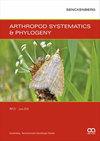物种与生态型的细微差别:以蒙古同地分布的halodendri和A. kozlovi为例(鞘翅目:天牛科)
IF 1.8
2区 农林科学
Q2 ENTOMOLOGY
引用次数: 6
摘要
本文以发生在蒙古干旱区的卤代无节幼体和科兹洛维无节幼体(鞘翅目:Cerambycidae)为例,探讨了生态适应问题。通过应用综合分类学方法,我们揭示了Polyphaga中第一个有记录的同域生态型病例和Cerambycidae科中第二个生态型病例。生态数据分析、线粒体(COI)和细胞核(ArgK和CAD)基因的分子分析以及详细的形态学检查的结果,包括对男性生殖器(包括内生殖器结构)的研究,支持了这两个通常被认为是独立物种的实体,仅代表分别与岩石丘陵和沙质/砾石平原相关的生态适应形式。因此,恢复了一个同义词:Anoplistes halodendri minutus Hammarström,1892=Asias kozlovi Semenov和Znojko,1934,syn。在这些不同的生境中,鞘翅模式和阴影的差异似乎适应了不同的基质。一种可能的情况是,在戈壁沙漠形成期间(约24至2.6 Ma),在该地区干旱化加剧的过程中,这两种形式在平行物种形成的情况下,独立地在多个种群中出现,并且它们可能在未来进化成单独的物种。分析了代表Trachyderini部落亲缘关系最密切属的一些分类群的系统发育关系,并证实了雅各布无节线虫的可疑物种地位。Anoplistes属和Amarysius属的一些物种之间的内部特征结构的低种间差异表明,它们在进化上是相对年轻的群体。还讨论了生态型和亚种之间的实际差异。节肢动物系统学与系统发育792021,1-23|DOI 10.3897/asp.79.e61499版权所有Lech Karpiński。这是一篇根据知识共享署名许可证(CC BY 4.0)条款分发的开放获取文章,该许可证允许在任何媒体上不受限制地使用、分发和复制,前提是原始作者和来源可信。Karpiński等人:物种和生态型2之间的细线本文章由计算机程序翻译,如有差异,请以英文原文为准。
A fine line between species and ecotype: a case study of Anoplistes halodendri and A. kozlovi (Coleoptera: Cerambycidae) occurring sympatrically in Mongolia
This paper discusses ecological adaptation based on a case study of Anoplistes halodendri and Anoplistes kozlovi (Coleoptera: Cerambycidae) that occur in the arid zone of Mongolia. By applying an integrative taxonomy approach, we revealed one of the first documented cases of sympatrically occurring ecotypes in Polyphaga and the second case of ecotypes in the family Cerambycidae. The results of the analysis of the ecological data, molecular analysis of mitochondrial (COI) and nuclear (ArgK and CAD) genes, as well as a detailed morphological examination, which consisted of a study on the male genitalia including the endophallic structures, supported the hypothesis that these two entities, which are commonly considered separate species, represent only ecologically adapted forms that are associated with rocky hills and sandy/gravelly plains, respectively. Therefore, a synonym is restored: Anoplistes halodendri minutus Hammarström, 1892 = Asias kozlovi Semenov and Znojko, 1934, syn. res. The differences in the elytral pattern and shade appear to be adapted to the different substrates in these distinct habitats. A probable scenario assumes that these two forms arose in parapatry, independently in multiple populations, under parallel speciation during the intensification of the aridification across the region in the period during which the Gobi Desert was formed (~ 24 to 2.6 Ma) and they may evolve into separate species in the future. The phylogenetic relationships of some taxa representing the most closely related genera of the tribe Trachyderini were analysed and the questioned species status of Anoplistes jacobsoni was confirmed. Low interspecific differences in the endophallic structures in the genus Anoplistes and between some species of the genus Amarysius indicate that they are evolutionarily relatively young groups. The practical differences between ecotype and subspecies are also discussed. Arthropod Systematics & Phylogeny 79, 2021, 1–23 | DOI 10.3897/asp.79.e61499 Copyright Lech Karpiński. This is an open access article distributed under the terms of the Creative Commons Attribution License (CC BY 4.0), which permits unrestricted use, distribution, and reproduction in any medium, provided the original author and source are credited. Karpiński et al.: A fine line between species and ecotype 2
求助全文
通过发布文献求助,成功后即可免费获取论文全文。
去求助
来源期刊

Arthropod Systematics & Phylogeny
Agricultural and Biological Sciences-Insect Science
CiteScore
2.50
自引率
5.60%
发文量
26
审稿时长
12 weeks
期刊介绍:
Arthropod Systematics & Phylogeny releases three times per year. Research fields covered are the taxonomy, morphology/anatomy, phylogeny (molecular or morphology-based), historical biogeography and palaeontology of arthropod taxa.
Arthropod Systematics & Phylogeny is the successor of Entomologische Abhandlungen, formerly published by the Museum of Zoology Dresden, Germany.
 求助内容:
求助内容: 应助结果提醒方式:
应助结果提醒方式:


